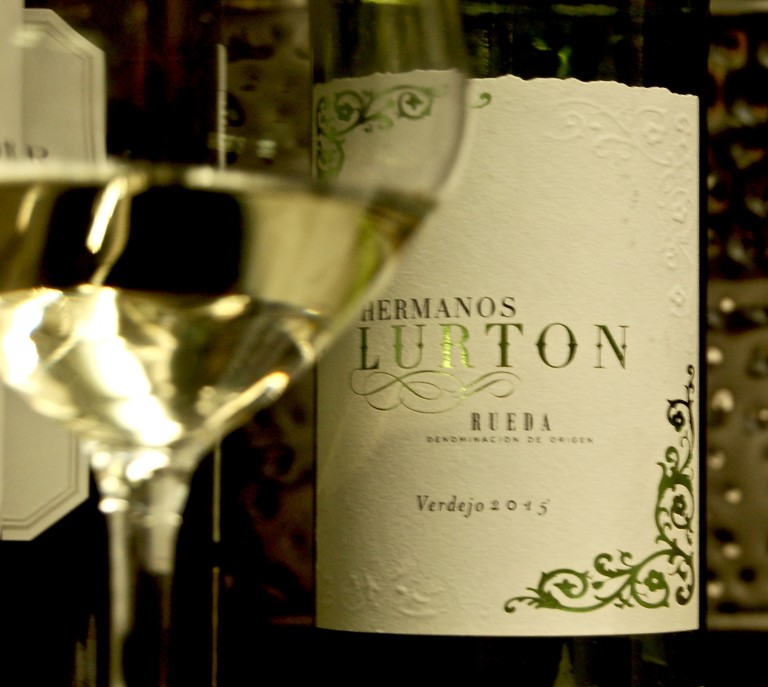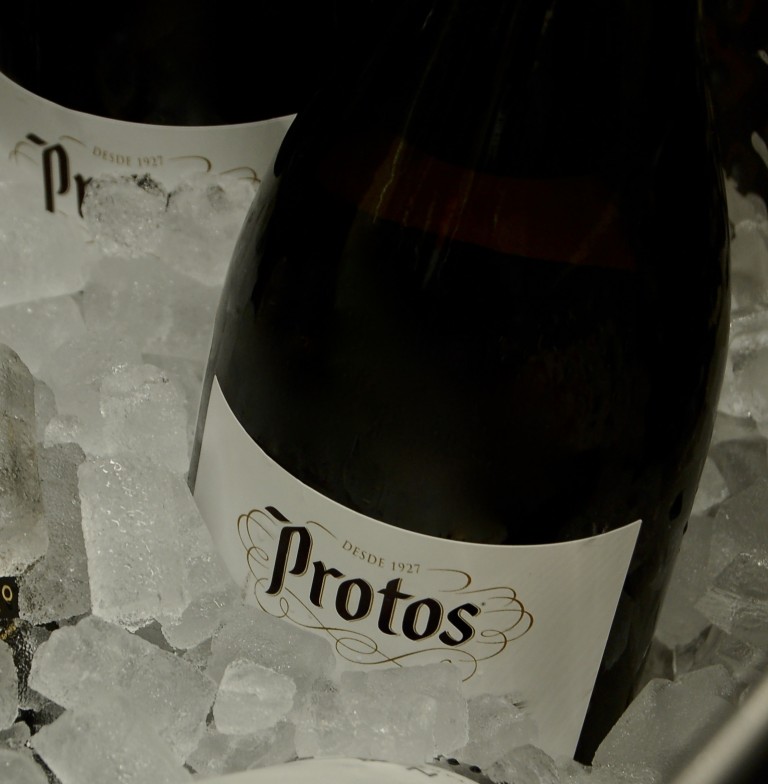Exploring the Wines of Ribera y Rueda
All photos by Amy Miller.
"A bottle of red, a bottle of white . . ."
Three years ago my husband and I spent a month in San Sebastian, Spain, and did our daily shopping at a postage-stamp sized grocery store that carried a tiny but brilliantly curated selection of goods: freshly sliced jamon, aged Manchego, and just-picked white asparagus still covered in the red soil of nearby Navarra. The store also managed to find room for quite a few bottles of good wines, surprisingly, none of which exceeded 5 euros. A favorite among them was a Verdejo from Rueda, which I still remember as crisp and refreshing with more going on in the glass than could possibly be expected for $7 a bottle.
Rueda is a small wine region about an hour and a half northwest of Madrid (3 hours southwest of San Sebastian) and is known almost exclusively for its white wines made from Verdejo. Small amounts of Sauvignon Blanc and Viura are also grown but are more often used for blending than bottled as varietal wines. We drank a lot of Verdejo over the course of that summer, and were surprised by two things: one, the subtle variety of expressions and two, the consistent quality at such a low price. The wines all shared a bright acidity and minerality, but some were lean and crisp while others showed more texture and creaminess. Occasionally a hint of oak would appear. Only recently have Rueda wines been brought to the states, but they're worth seeking out among the sea of inexpensive whites filling the store shelves. When it comes to the price/quality ratio it's a hard wine to beat.
Like many of Spain's other wine regions Rueda's rebirth has come about only in the last few decades. Although winemaking in the region dates back more than a thousand years, the phylloxera epidemic in the late 1800s wiped out most of the vines. Vineyards were later replanted with Palomino and used to make a fortified wine not unlike sherry. It wasn't until the 1970s and the end of Franco's rule that things started to change. Marqués de Riscal, one of Rioja's oldest wineries, was the first to test the vinous waters of Rueda with a white wine based on Verdejo. Although it's a difficult vine to grow the results were a success, and soon other winemakers began to see the potential of the region. The DO was established in 1980, and in the last ten years alone the industry has nearly doubled to 70 wineries, 1500 growers, and 13,000 hectares of land under vine.
Part of Verdejo's success here has to do with the specific conditions and terroir. The region sits on the Castilla y León plateau, at an average of elevation of 700 meters. This results in hot days and cool nights, which helps retain acidity and flavors. Most vineyards are planted along the Duero River or its tributaries, providing a water source in this arid, hard-scrabble land. In the winery too, investments in modern winemaking technology have kept quality high and consistent.
Many of the wineries who have set up shop in Rueda came from neighboring Ribera del Duero, a region that stretches for 115 km along the banks of the Duero River. It's an area known for its deep, powerful reds, so Ribera winemakers saw Rueda's whites as a natural complement. So much so that the two regions recently united to form a new marketing campaign called Ribera y Rueda. It was a natural fit, according to Felipe Gonzalez-Gordon who is leading the efforts here in the U.S. "Because of geographic proximity, a number of companies have wineries in both regions, so they decided to come together, pool their resources and make a common effort."
Like Rueda, Ribera del Duero's DO was established relatively recently (in 1982) but its reputation for quality was secured early by its most famous winery Vega Sicilia. Established in 1864 by Don Eloy Lecanda y Chaves, it has since become one of the world's great wines with a reputation on par with First Growth Bordeaux. The winery has served as a sort of anchor for the region, which now boasts 270 wineries, with 22,000 hectares under vine.
Although Vega Sicilia uses some Cabernet Sauvignon and Merlot, most reds here are made from the region's local variant of Tempranillo (Tinto Fino), which can withstand the hot daytime temperatures. Despite the emphasis on one grape variety, however varying weather conditions year to year as well as differences in soil, altitude, and exposure result in a multitude of expressions. Ribera sits on the same plateau as Rueda, with most vineyards at altitude of 700 to 850 meters, which means a short growing season and extreme diurnal temperature variation. At a recent tasting of Ruedas and Ribera del Duero's those differences were on full display. Here are some of the highlights.
RUEDA WHITES
Marqués de Cáceres 2015. One of Rioja's largest producers recently expanded into Rueda to meet the growing demand for its white wines. Their Verdejo is sourced from 20-year-old vines and vinified in stainless steel to preserve the fresh fruit flavors. Early efforts are promising. The 2015 is crisp and aromatic, showing bright flavors of lemon, green apple, passion fruit and melon with a touch of saltiness and minerality, and all for only $9.
Viña Mayor 2015. This wine's aromas feature less citrus and more melon, while on the palate there is more texture and weight from fermenting in one- to two-year-old French oak barrels and aging two months on its lees. A lovely burst of mint/anise surprises at the end. $9.
Protos 2013. Right out of the bottle you'll notice this wine is darker in color, and more golden. The grapes were hand harvested at night when it is cold and macerated on the skins for 4-5 hours before fermenting in new French oak barrels. It spends another 6 months in French oak on the less with battonage. It's a more powerful expression, with toasty oak notes, lemon pith, golden apples, anise and vanilla. $15.
Hermanos Lurton, 2015. This highly esteemed Bordeaux family has been making wine in Rueda since 1992. Not only do they farm biodynamically, but their vinification techniques also lend a hand in creating a unique wine. Grapes were hand harvested, macerated on the skins, fermented in oak barrels of different sizes, and aged on fine lees in stainless steel vats for 3 months. Golden apple, pear and floral notes, predominate on the palate along with candied green apple, and a hint of pineapple. There is a lovely streak of minerality and great texture. $16
Harenna 2014. Harenna means sand, and is the predominant soil type found in this old vineyard, which sits at the confluence of two rivers. The sand turned out to be providential and protected the vines from the phylloxera infestation in the 1800s. The vineyard is therefore dotted with rare, ungrafted vines that average 150 years old. The grapes are hand harvested, then cold macerated for 12 hours before fermenting in stainless steel for 21 days. The results offer up a dense, creamy wine with exceptional complexity of lemon pith, passion fruit, apple, tropical fruit, golden apple, mango, papaya, and minerality. $14.
RIBERA DEL DUERO REDS
Emina Prestigio Crianza, 2012.
Emina is part of the Matarromera group, which owns six other wineries, including one in Rueda. The 2012 vintage was marked by long stretches of drought, resulting in reduced yields and hence, deeply concentrated wines. The Emino Prestigio Crianza was no exception. Fermentation was 21 days in stainless steel followed by 16 months in American and French oak and 16 months aged in bottle. Four years on it's still in its youth with grippy, fine-grained tannins, but well balanced by the ripe blackberries, tobacco, and coffee beans. $30
When Javier Alonso and María del Yerro founded their winery in 2002 they brought in the noted Bordeaux consultant Stéphane Derenoncourt. The 2010 vintage, considered one of the best of the decade, was the result of a rainy summer followed by a warm, dry autumn that allowed the grapes to ripen slowly but steadily. The grapes were then macerated for 25 to 29 days and aged 12 months in French oak barrels (25% new). The wine is deeply concentrated with ripe black cherries, leather, and anise but well balanced by the high acid and fine-grained, well-integrated tannins. A surprisingly elegant, structured wine. $23.




